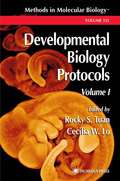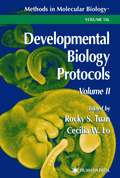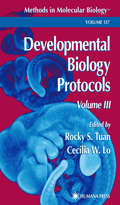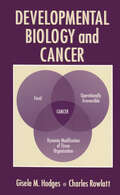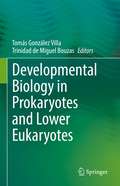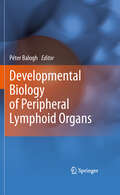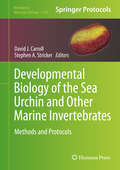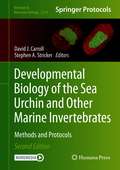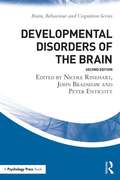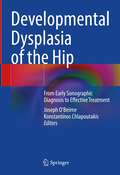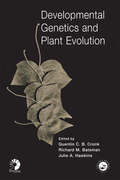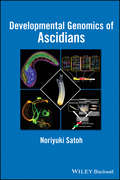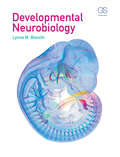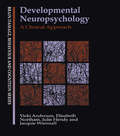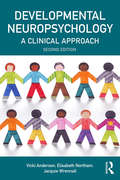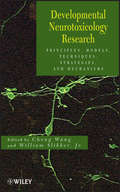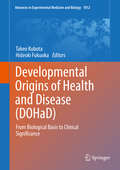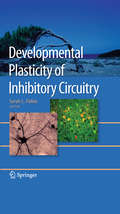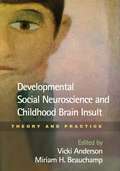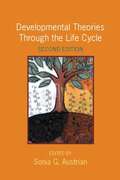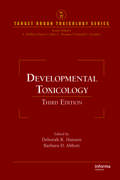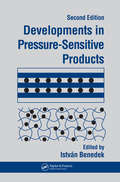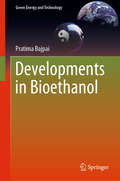- Table View
- List View
Developmental Biology Protocols, Volume I
by Rocky S. Tuan Cecilia W. LoDrawing on state-of-the-art cellular and molecular techniques as well as new and sophisticated imaging and information technologies, this comprehensive, three-volume collection of cutting-edge protocols provides readily reproducible methods for studying and analyzing the events of embryonic development. Volume 1 (ISBN: 089603-574-3) contains techniques for establishing and characterizing several widely used experimental model systems, for the study of developmental patterns and morphogenesis, and for the examination of embryo structure and function. There are also step-by-step methods for the analaysis of cell lineage, the production and use of chimeras, and the experimental and molecular manipulation of embryos, including the application of viral vectors. Volume 2 (ISBN: 0-89603-575-1) describes state-of-the-art methods for the study of organogenesis, the analysis of abnormal development and teratology, the screening and mapping of novel genes and mutations, and the application of transgenesis, including the production of transgenic animals and gene knockouts. No less innovative, volume 3 (ISBN: 0-89603-576-X) introduces powerful techniques for the manipulation of developmental gene expression and function, the analysis of gene expression, the characterization of tissue morphogenesis and development, the in vitro study of differentiation and development, and the genetic analysis of developmental models of diseases. Highly practical and richly annotated, the three volumes of Developmental Biology Protocols describe multiple experimental systems and details techniques adopted from the broadest array of biomedical disciplines.
Developmental Biology Protocols, Volume II
by Rocky S. Tuan Cecilia W. LoDrawing on state-of-the-art cellular and molecular techniques as well as new and sophisticated imaging and information technologies, this comprehensive, three-volume collection of cutting-edge protocols provides readily reproducible methods for studying and analyzing the events of embryonic development. Volume 1 (ISBN: 089603-574-3) contains techniques for establishing and characterizing several widely used experimental model systems, for the study of developmental patterns and morphogenesis, and for the examination of embryo structure and function. There are also step-by-step methods for the analaysis of cell lineage, the production and use of chimeras, and the experimental and molecular manipulation of embryos, including the application of viral vectors. Volume 2 (ISBN: 0-89603-575-1) describes state-of-the-art methods for the study of organogenesis, the analysis of abnormal development and teratology, the screening and mapping of novel genes and mutations, and the application of transgenesis, including the production of transgenic animals and gene knockouts. No less innovative, volume 3 (ISBN: 0-89603-576-X) introduces powerful techniques for the manipulation of developmental gene expression and function, the analysis of gene expression, the characterization of tissue morphogenesis and development, the in vitro study of differentiation and development, and the genetic analysis of developmental models of diseases. Highly practical and richly annotated, the three volumes of Developmental Biology Protocols describe multiple experimental systems and details techniques adopted from the broadest array of biomedical disciplines.
Developmental Biology Protocols, Volume III
by Rocky S. Tuan Cecilia W. LoDrawing on state-of-the-art cellular and molecular techniques as well as new and sophisticated imaging and information technologies, this comprehensive, three-volume collection of cutting-edge protocols provides readily reproducible methods for studying and analyzing the events of embryonic development. Volume 1 (ISBN: 089603-574-3) contains techniques for establishing and characterizing several widely used experimental model systems, for the study of developmental patterns and morphogenesis, and for the examination of embryo structure and function. There are also step-by-step methods for the analaysis of cell lineage, the production and use of chimeras, and the experimental and molecular manipulation of embryos, including the application of viral vectors. Volume 2 (ISBN: 0-89603-575-1) describes state-of-the-art methods for the study of organogenesis, the analysis of abnormal development and teratology, the screening and mapping of novel genes and mutations, and the application of transgenesis, including the production of transgenic animals and gene knockouts. No less innovative, volume 3 (ISBN: 0-89603-576-X) introduces powerful techniques for the manipulation of developmental gene expression and function, the analysis of gene expression, the characterization of tissue morphogenesis and development, the in vitro study of differentiation and development, and the genetic analysis of developmental models of diseases. Highly practical and richly annotated, the three volumes of Developmental Biology Protocols describe multiple experimental systems and details techniques adopted from the broadest array of biomedical disciplines.
Developmental Biology and Cancer
by Gisele M. Hodges Charles RowlattThis book addresses possible analogies between cancer and developmental biology. An international group of experts provides a multidisciplinary approach, allowing biological or clinical scientists involved with cancer research to integrate specific information from diverse areas.Five concepts of cancer are presented, and developmental biology is reviewed at five levels. These are integrated in discussions of failure in organisation as a basis of cancer and its control. The book will be a valuable reference for both newcomers as well as experienced biological and clinical scientists.
Developmental Biology in Prokaryotes and Lower Eukaryotes
by Tomás González Villa Trinidad de Miguel Bouzas‘Developmental biology’ is widely understood as processes, which mainly concern embryonic animal development and differentiation of cells and tissue. It is also often defined as the timeline for the evolutionary developmental biology of eukaryotic multicellular higher organisms, i.e., plants and animals. The development of prokaryotes and lower eukaryotes in contrary has been neglected for a long time, which was the motivation for publishing this book. This book highlights one of Darwin's most important findings: Evolution is a creative, but not a conscious process. It also illustrates that this concept does not only apply to multicellular higher organisms, but affects every form of life.The reader shall find complex biochemical and genetic pathways of bacteria, yeasts or protozoa, comparable to those exhibited by plants or animals. The molecular mechanisms of dramatic genome rearrangements, recombination and horizontal gene transfer that are responsible for evolutionary adaptations are discussed. Additionally, the book covers bacteria of the genera Myxobacteriales and Caulobacterales, which are able to develop tissue-like cellular organization. The morphogenesis of entomopathogenic fungi and the endosymbiont theory are also addressed. The book is a useful introduction to the field for junior scientists, interested in bacteriology, protistology and fungal development. It is also an interesting read for advanced scientists, giving them a broader view of the field beyond their area of specialization.
Developmental Biology of Peripheral Lymphoid Organs
by Peter BaloghThe human immune system is a complex network of tissues and organs dispersed throughout the body. Immunology, as one of the most rapidly evolving fields in bio¬medical research, has to date covered the essential cellular and molecular events neces¬sary for immune responses to occur. However, it has paid relatively little attention to important developmental processes underlying the formation of the tissues themselves that carry out immune responses in humans and other mammalians. In contrast to the thymus and bone marrow that are the sole tissues for generating mature leukocytes for antigen recognition and han¬dling in humans and most mammalian species, the peripheral lymphoid tissues where adaptive immune responses are focused display broad tissue distribution and possess diverse archi¬tectural characteristics. These organs develop prior to the individual's exposure to external antigens, and despite their similar functions, their varied appearances indicate a substantial complexity of tissue ontogeny. This volume presents a comprehensive overview of the developmental features of the major peripheral lymphoid organs, thus examining the connection between immunological functionality and structural characteristics utilizing a developmental approach, for an audience ranging from undergraduate students to senior researchers in immunology, histology and clinical medicine.
Developmental Biology of the Sea Urchin and Other Marine Invertebrates
by David J. Carroll Stephen A. StrickerIn Developmental Biology of the Sea Urchin and Other Marine Invertebrates: Methods and Protocols, expert researchers in the field detail many of the methods which are now used to study sea urchins and other marine invertebrates in the laboratory. These include methods and protocols on imaging, other useful experimental tools for cell, developmental biology research, variety of molecular biological methods, and strategies for utilizing the sea urchin genome. Written in the highly successful Methods in Molecular Biology series format, chapters include introductions to their respective topics, lists of the necessary materials and reagents, step-by-step, readily reproducible laboratory protocols, and key tips on troubleshooting and avoiding known pitfalls. Authoritative and practical, Developmental Biology of the Sea Urchin and other Marine Invertebrates: Methods and Protocols seeks to aid scientists in the further study into sea urchins and other marine invertebrates.
Developmental Biology of the Sea Urchin and Other Marine Invertebrates: Methods and Protocols (Methods in Molecular Biology #2219)
by David J. Carroll Stephen A. StrickerThis detailed second edition presents a wide variety of marine invertebrate model systems, from cephalochordata to holothurians, along with novel experimental protocols for taking advantage of their unique properties. The techniques range from culturing the organisms to modifying their DNA. Written for the highly successful Methods in Molecular Biology series, chapters include introductions to their respective topics, lists of the necessary materials and reagents, step-by-step, readily reproducible laboratory protocols, and tips on troubleshooting and avoiding known pitfalls. Authoritative and up-to-date, Developmental Biology of the Sea Urchin and Other Marine Invertebrates: Methods and Protocols, Second Edition is an ideal guide for researchers working with these versatile organisms and for furthering our understanding of fundamental biological questions.
Developmental Disorders of the Brain: Neuropsychological, Neuropsychiatric And Evolutionary Perspectives (Brain, Behaviour and Cognition)
by Nicole J. Rinehart John L. Bradshaw Peter G. EnticottDevelopmental Disorders of the Brain: Brain and Behaviour addresses disabilities that occur or have their roots in the early, developmental phase of life which are of utmost concern to parents, siblings, carers and teachers. This text describes the latest clinical and behavioral findings of disorders which largely or entirely involve the frontostriatal (basal ganglia) system including Tourette's, Obsessive-Compulsive and Attention-Deficit-Hyperactivity disorders, Schizophrenia, Autism, gambling and addiction, depression, and Conduct, Developmental Motor Co-ordination, and language disorders. Examples of disorders involving the frontocerebellar are also described such as Asperger's disorder, Williams, Fragile X, and Cerebellar Cognitive Affective syndromes, and Friedreich Ataxia. This book also discusses the relevant anatomy, physiology and pathology, and some of the major functions mediated by affected or relevant structures, together with accounts of the latest recording, brain imaging and stimulating techniques related to these kinds of disorders. Covering both frontostriatal and frontocerebellar, systems which control and direct normal behavior, and which can fail with often distressing consequences during development, as well as addressing behavioural, clinical, pathophysiological and technical aspects, this text is vital to understanding, diagnosis and management of developmental disorders of the brain. This text will be of great interest to clinicians, researchers, teachers and parents.
Developmental Dysplasia of the Hip: From Early Sonographic Diagnosis to Effective Treatment
by Joseph O’Beirne Konstantinos ChlapoutakisThis book is a reference source containing all the relevant information about Developmental Dysplasia of the Hip (DDH), for people who practice or utilize hip sonography for the early detection and treatment of DDH. It aims at improving the population screening for DDH, thus contributing to the elimination of the disorder and its devastating consequences. What makes this book different from existing literature is the fact that, apart from the (updated) information about the disorder (including development, pathophysiology, etiology, pathogenesis, risk factors etc.) and a short technical guidance, the reader will find all relevant knowledge to organize training and set up screening. This includes analysis of the rationale behind universal sonographic screening, a comparative presentation of the sonographic techniques, teaching course structure / management and setting up a screening service, including audit, quality control of the scans etc. Special chapters about radiological diagnosis, imaging the consequences of non-diagnosis or maltreatment of the disorder, clinical management of DDH cases and shaping the future of hip sonography, are also provided. The book will be of interest to any medical doctor, but in particular to those working in the fields of radiology, pediatrics, orthopedics or general medicine, sonographers performing hip scans, or specialist nurses dealing with DDH.
Developmental Genetics and Plant Evolution (Systematics Association Special Volumes)
by Richard M. Bateman Quentin C. B. Cronk Julie A. HawkinsA benchmark text, Developmental Genetics and Plant Evolution integrates the recent revolution in the molecular-developmental genetics of plants with mainstream evolutionary thought. It reflects the increasing cooperation between strongly genomics-influenced researchers, with their strong grasp of technology, and evolutionary morphogenetists and sys
Developmental Genomics of Ascidians
by Noriyuki SatohThe simplicity and lack of redundancy in their regulatory genes have made ascidians one of the most useful species in studying developmental genomics. In Developmental Genomics of Ascidians, Dr. Noriyuki Satoh explains the developmental genomics of ascidians, stresses the simplicity of Ciona developmental system, and emphasizes single-cell level analyses. This book actively accentuates the advantages of using ascidians as model organisms in an up-and-coming field of developmental genomics.
Developmental Neurobiology
by Lynne BianchiDevelopmental Neurobiology tells the extraordinary process of neural development by showing how the scientific discoveries were made and how the hypotheses evolved over time. Each chapter explores the specific mechanisms of development while highlighting the key experiments and methods used to make those discoveries—including descriptions of, and experiments utilizing, both invertebrate and vertebrate animal models. This distinctive approach provides the essential facts while strengthening the reader’s appreciation of the scientific method. Discussions of neurodevelopmental disorders and therapeutic approaches to them will captivate those interested in the more clinical aspects of the field. With its clear illustrations and easy-to-follow writing style, Developmental Neurobiology presents an accessible approach to neural development for undergraduate students.
Developmental Neuropsychology: A Clinical Approach
by Vicki Anderson Elisabeth Northam Jacquie WrennallThis book addresses key issues in child neuropsychology but differs from other books in the field in its emphasis on clinical practice rather than research issues. Although research findings are presented, they are described with emphasis on what is relevant for assessment, treatment and management of pediatric conditions. The authors have chosen to focus on a number of areas. First, the text examines the natural history of childhood CNS insult, highlighting studies where children have been followed over time to determine the impact of injury on ongoing development. Second, processes of normal and abnormal cerebral and cognitive development are outlined and the concepts of brain plasticity and the impact of early CNS insult discussed. Finally, using a number of common childhood CNS disorders as examples, the authors develop a model which describes the complex interaction among biological, psychosocial and cognitive factors in the brain injured child.The text will be of use on advanced undergraduate courses in developmental neuropsychology, postgraduate clinical training programmes, and for professionals working with children in clinical psychology, clinical neuropsychology, and in educational and rehabilitation contexts.
Developmental Neuropsychology: A Clinical Approach (Brain, Behaviour and Cognition)
by Vicki Anderson Elisabeth Northam Jacquie WrennallThis fully updated edition of Developmental Neuropsychology: A Clinical Approach addresses key issues in child neuropsychology with a unique emphasis on evidence-informed clinical practice rather than research issues. Although research findings are presented, they are described with emphasis on what is relevant for assessment, treatment and management of paediatric conditions. The authors focus on a number of areas. First, the text examines the natural history of childhood central nervous system (CNS) insult, highlighting studies where children have been followed over time to determine the impact of injury on ongoing development. Second, processes of normal and abnormal cerebral and cognitive development are outlined and the concepts of brain plasticity and the impact of early CNS insult discussed. Third, using a number of common childhood CNS disorders as examples, the authors develop a model which describes the complex interaction among biological, psychosocial and cognitive factors in the brain-injured child. Finally, principles of evidence-based assessment, diagnosis and intervention are discussed. The text will be of use on advanced undergraduate courses in developmental neuropsychology, postgraduate clinical training programmes and for professionals working with children in clinical psychology, clinical neuropsychology and educational and rehabilitation contexts. The text is also an important reference for those working in paediatric research.
Developmental Neurotoxicology Research: Principles, Models, Techniques, Strategies, and Mechanisms
by Jr. Cheng Wang William SlikkerThis book describes how systems biology, pharmacogenomic and behavioral approaches, as applied to neurodevelopmental toxicology, provide a structure to arrange information in a biological model. Authors review and discuss approaches that can be used as effective tools to dissect mechanisms underlying pharmacological and toxicological phenomena associated with the exposure to drugs or environmental toxicants during development. This book presents cross-cutting research tools and animal models, along with applications to the studies associated with potential anesthetic-induced developmental neurotoxicity; the developmental basis of adolescent or adult onset of disease; risk assessment of methyl mercury and its effects on neurodevelopment; challenges in the field to identify environmental factors of relevance to autism; and the strategy and progress of epilepsy research.
Developmental Origins of Health and Disease: From Biological Basis to Clinical Significance (Advances in Experimental Medicine and Biology #1012)
by Takeo Kubota Hideoki FukuokaThis book addresses the developmental origins of health and disease (DOHaD), a new medical concept that demonstrates that various adult diseases start in the fetal period. It discusses our current understanding of the molecular mechanisms of DOHaD, including gene body epigenetics and non-coding RNA, and comprehensively examines diseases such type 2 diabetes, a well known as standard DOHaD-associated disease, as well as non-alcoholic fatty liver disease, hypertension and neurodevelopmental disorders. It argues that most adult diseases start at a very early stage, such as in the fetal and neonatal periods, and that earlier prevention and intervention would result in better outcomes for adult diseases such as type 2 diabetes and cardiac disorders, which are increasing in both developed and developing countries. The book appeals to obstetricians and pediatricians, as well as physicians who treat adult patients, wanting to understand the origins of diseases.
Developmental Plasticity of Inhibitory Circuitry
by Sarah L. PallasNeuroscience has long been focused on understanding neural plasticity in both development and adulthood. Experimental work in this area has focused almost entirely on plasticity at excitatory synapses. A growing body of evidence suggests that plasticity at inhibitory GABAergic and glycinergic synapses is of critical importance during both development and aging. The book brings together the work of researchers investigating inhibitory plasticity at many levels of analysis and in several different preparations. This topic is of wide relevance across a number of different areas of research in neuroscience and neurology. Medical problems such as epilepsy, mental illness, drug abuse, and movement disorders can result from malfunctioning inhibitory circuits. Further, the maturation of inhibitory circuits may trigger the onset of critical periods of neural circuit plasticity, raising the possibility that such plastici periods could be reactivated for medical benefit by manipulating inhibitory circuitry.
Developmental Social Neuroscience and Childhood Brain Insult
by Vicki Anderson Miriam H. BeauchampSynthesizing cutting-edge knowledge from multiple disciplines, this book explores the impact of acquired brain injury and developmental disabilities on children's emerging social skills. The editors present an innovative framework for understanding how brain processes interact with social development in both typically developing children and clinical populations. Key issues in assessment are addressed, including ways to measure both social function and brain function using developmentally sound tools. Balancing theoretical and clinical concerns, the book describes promising interventions for promoting children's adjustment and helping them participate more fully in the social world. Illustrations include six color plates.
Developmental Theories Through the Life Cycle (2nd Edition)
by Sonia G. AustrianThe life cycle, until recently, has been neither descriptive nor conceptual but metaphorical, suggesting an underlying sequence of events that everyone experiences rather than clear external milestones of development, althought every life, of course, is acknowledged to be unique.
Developmental Toxicology (Target Organ Toxicology Series)
by Deborah K. Hansen Barbara D. AbbottHighlighting latest advances in genetics and biochemistry, the completely revised Third Edition reviews the field from basic science, clinical, epidemiological, and regulatory perspectives. Contributions from top opinion leaders in the field bring together developments in molecular embryology and cell biology as they apply to problems in developmen
Developmental Toxicology: Methods and Protocols (Methods in Molecular Biology #1965)
by Jason M. Hansen Louise M. WinnThis thorough edition explores numerous methodological approaches that can be extremely informative for our understanding of the developmental toxicant mechanisms, characterization of developmental outcomes, and development of potential interventions that are clinically relevant. Presenting both staple and state-of-the-art approaches, the book focuses on numerous cellular models (induced pluripotent stem cells, neural crest culture, etc.), some less frequently used but important animal models (chick, zebrafish), in vitro approaches using whole embryos (rat, mouse and rabbit), and specific outcome methodologies to assess changes on the morphological to molecular level. Written for the highly successful Methods in Molecular Biology series, chapters include the kind of detail and expert implementation advice that allows for smooth processes in the lab. Authoritative and practical, Developmental Toxicology: Methods and Protocols, Second Edition serves as an ideal aid to support further investigation into the specific mechanisms and outcomes of developmental exposures.
Developmental and Reproductive Toxicology: A Practical Approach
by Ronald D. HoodCompletely revised and updated, Developmental and Reproductive Toxicology: A Practical Approach, Second Edition draws together valuable information typically scattered throughout the literature, plus some not previously published, into one complete resource. In addition to the traditional aspects of developmental toxicity testing, the book covers e
Developments In Pressure-Sensitive Products
by István BenedekSince the first groundbreaking edition of Developments in Pressure-Sensitive Products was introduced in 1998, heavy research has resulted in substantial progress in the field. Fully updated and expanded to reflect this activity, Developments in Pressure-Sensitive Products, Second Edition provides a detailed overview of the entire range of pressure-
Developments in Bioethanol (Green Energy and Technology)
by Pratima BajpaiThis book provides an updated and detailed overview on the recent developments of bioethanol technology. It looks at the historical perspectives, chemistry, sources and production of ethanol and discusses biotechnology breakthroughs and promising developments, its uses, advantages, problems, environmental effects and characteristics. In addition, it presents information about ethanol in different parts of the world and also highlights the challenges and future of ethanol. The first edition of this book was published as a SpringerBriefs in 2013. Since then, many new developments have taken place in the last six years. This new edition will highlight the evolution in bioethanol development from first-generation production to the futuristic fourth-generation bioethanol production, the various constraints and challenges involved, and the scope for development. This book caters to the audience who are interested in alternative transportation fuels which are both biodegradable and sustainable to the environment.
